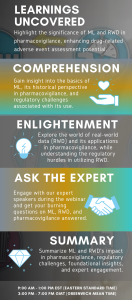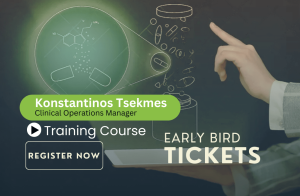
Webinar Description
The objective of this webinar is to discuss both the science and regulatory challenges in two areas of research that have great potential to advance the identification and assessment of drug-related adverse events. ML, a type of artificial intelligence, is showing promise as a tool to enhance drug causality assessments, among other areas in the PV life cycle. Similarly, RWD is providing a wealth of information to help further our understanding and mitigation of drug-related adverse events in the general population. However, there are significant regulatory implications for the use of such data, that will be presented and discussed.Why Attend this Training?
By attending this webinar, you will:
- Understand the significance of ML and RWD in pharmacovigilance
- Understand basic ML terminology
- Introduce to Historical perspective of ML and how it applies to PV
- Understand the regulatory challenges in using ML in PV
- Learn a practical example on a ML approach to assist in drug causality assessments
- Understand what RWD is and its applications in PV
- Understand the regulatory challenges in identifying and using RWD functions

Who should attend?
This webinar is relevant for:

All Pharma professionals supporting pharmacovigilance ML/RWD activities, responsible for Pharmacovigilance case processing and safety science including IT and Regulatory stuff
- Pharmacovigilance experts
- Safety experts
- Regulatory strategy and regulatory affairs Professionals
- Medical writers
- Data scientists
- Risk management planning and development
- IT professionals
About the trainers
Bruce Donzanti – Pharmacovigilance and Regulatory Policy Consultant
 Bruce received his doctorate in pharmacology from The Ohio State University with a focus on neuropharmacology / neuroscience. Although starting out in academics, Bruce has spent the majority of his career in the pharmaceutical industry, working in several therapeutic areas involving pre-clinical pharmacology & toxicology, regulatory affairs, and clinical research. For almost 30 years, Bruce has had roles in various US and global pharmacovigilance positions for Pfizer, Johnson & Johnson, and Genentech/Roche. His focus now is primarily on the evaluation and regulatory policies of new technologies and data sources, such as potential applications of machine learning and use of real world data, to enhance the identification and assessment of drug-related adverse events. Some recent publications to support these efforts include: A Study on the Application and Use of Artificial Intelligence to Support Drug Development, Clin Ther (2019); Industry Assessment of the Contribution of Patient Support Programs, Market Research Programs, and Social Media to Patient Safety, Ther Innov Regul Sci (2019); Advancing Nonclinical Innovation and Safety in Pharmaceutical Testing, Drug Discovery Today (2019); Pharmacovigilance is Everyone’s Concern: Let’s Work It Out Together, Clin Ther (2018); A New Erice Report Considering the Safety of Medicines in the 21 st Century, Drug Saf (2017)
Bruce received his doctorate in pharmacology from The Ohio State University with a focus on neuropharmacology / neuroscience. Although starting out in academics, Bruce has spent the majority of his career in the pharmaceutical industry, working in several therapeutic areas involving pre-clinical pharmacology & toxicology, regulatory affairs, and clinical research. For almost 30 years, Bruce has had roles in various US and global pharmacovigilance positions for Pfizer, Johnson & Johnson, and Genentech/Roche. His focus now is primarily on the evaluation and regulatory policies of new technologies and data sources, such as potential applications of machine learning and use of real world data, to enhance the identification and assessment of drug-related adverse events. Some recent publications to support these efforts include: A Study on the Application and Use of Artificial Intelligence to Support Drug Development, Clin Ther (2019); Industry Assessment of the Contribution of Patient Support Programs, Market Research Programs, and Social Media to Patient Safety, Ther Innov Regul Sci (2019); Advancing Nonclinical Innovation and Safety in Pharmaceutical Testing, Drug Discovery Today (2019); Pharmacovigilance is Everyone’s Concern: Let’s Work It Out Together, Clin Ther (2018); A New Erice Report Considering the Safety of Medicines in the 21 st Century, Drug Saf (2017)
Shaun Comfort MD, MBA -Principal Scientific Enablement Director @ Roche-Genentech PVSD-SEP

Dr. Comfort is a Principle Scientific Enablement Director for Roche in the Science Enablement and Process group, leading innovation work supporting Pharmacovigilance. He is a Board Certified Neurologist with 20+ years combined biopharma industry / regulatory experience including roles as former Medical Reviewer at the US FDA, Clinical Research and Safety at J&J, Anesiva, KCI, Cyberonics, Adaptix, and Genentech. Dr. Comfort’s current work focuses on combining machine-learning models and decision analysis techniques to evaluate Drug-Adverse Event causality and predict Project/Phase Probability of Success. His team’s work on Artificial Intelligence solutions for Pharmacovigilance resulted in two 2018 papers in Drug Safety: Sorting Through the Safety Data Haystack: Using Machine Learning to Identify Individual Case Safety Reports in Social- Digital Media and the MOdified NARanjo Causality Scale for ICSRs (MONARCSi): A Decision Support Tool for Safety Scientists. Recently he published his first book focused on using mathematical estimation in healthcare: How Much Is that Cure in the Window? Simple Math Solutions for Complicated Problems in Biology, Medicine, and Healthcare.
Grazyna Lieberman – RWD Strategy and Regulatory Policy Consultant

Grazyna (a.k.a. Gracie) Lieberman is a Biostatistician with 30+ years of experience in drug development. For the first twenty years of her drug development career, Gracie worked in the Biostatistics Department and the last ten years in Regulatory Policy. The regulatory policy focus areas were adoption and acceptance of innovative clinical trials, and Real-World Evidence in drug development and regulatory decision-making. While at Genentech, Gracie has gained experience in all phases of drug development, from pre-IND to post-marketing, drug/diagnostic co-development, and collection/evaluation of Patient Reported Outcomes (PROs). Gracie served on review and oversight committees, advising molecule development teams. She participated in select strategic initiatives such as 2 New Molecular Entities Development Considerations and led a Biostatistics Initiative on Drug/Diagnostic Co-Development. Gracie was also a panelist at a clinical conference organized by Friends of Cancer Research and Brookings Institute. The recommendations developed by the specific panel were key to the establishment of the Breakthrough Therapy Designation. Between 2020 and 2022 Gracie was co-leading a TransCelerate Initiative to develop recommendations for a checklist supporting RWD audit readiness and was a Lead Investigator in an FDA funded project to develop recommendations for study designs that reliably and rigorously combine data from different sources (e.g., a randomized clinical trial and RWD) and generate evidence that could be used to support regulatory decision-making. Gracie played a key role in initiating both projects.
Jeremy Jokinen – Vice President and Head, Global Risk managment @ Bristol Myers Squibb

Jeremy leads a global team of risk management and safety science leaders responsible for insights, evidence generation, and risk minimization efforts ensuring the safety of patients worldwide. Jeremy is also active within numerous cross-industry pharmacovigilance initiatives for DIA, TransCelerate, and ICH. Jeremy has over 20 years of experience in development and patient safety roles and as a statistician in early phase to post-market pharmaceutical, biological, and medical device research. He holds MS and PhD degrees in quantitative psychology from Ohio University.
Phil Tregunno – Deputy Director of Patient Safety Monitoring MHRA

Phil is the Deputy Director of Patient Safety Monitoring within MHRA’s Safety & Surveillance function and has over eighteen years of experience working in pharmacovigilance. Prior to his current role Phil spent fourteen years leading and developing the pharmacovigilance system, including technology, processes, and relevant aspects of Pharmacovigilance Legislation. He is now accountable for Patient Safety Monitoring across medicines, vaccines, devices, defects and blood products. Phil was responsible delivery of MHRA systems for COVID-19 vaccine surveillance and their integration into the healthcare system. For several years he has also led international projects to develop and deliver tools for global pharmacovigilance, which are now being used for surveillance internationally.
Advancing Pharmacovigilance using ML/RWE Event
EUR1199
Livestreaming Zoom _____ ✔️ Interactive Lectures _____ ✔️ FREE Recorded Webinar One Month Access _____ ✔️
18/100
SECURE YOUR SEAT
REGISTER NOW



